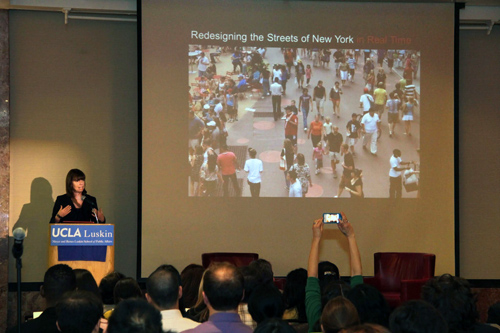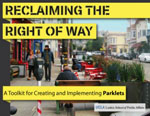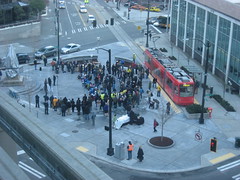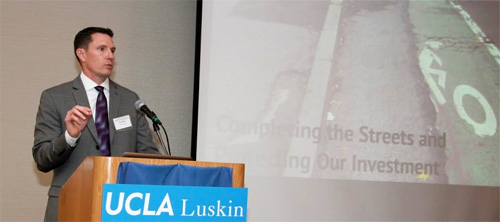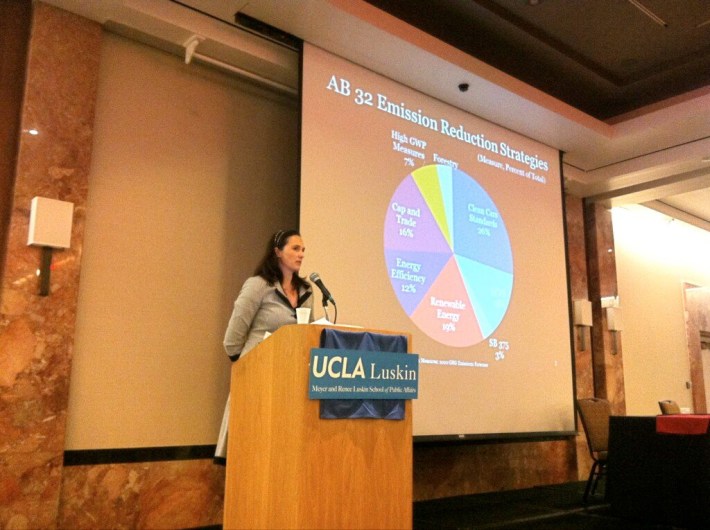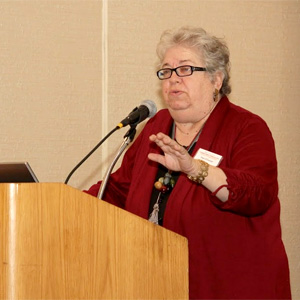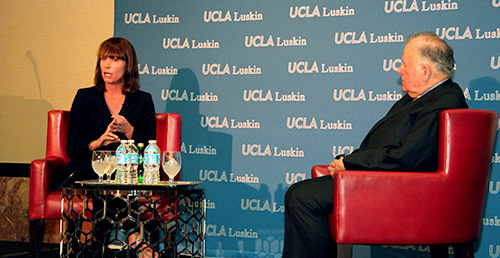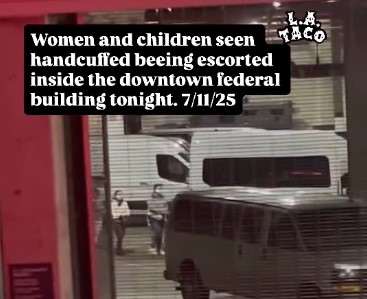Last Thursday UCLA hosted its third annual Complete Streets Conference in Downtown Los Angeles. I was excited to have had the opportunity to attend with such a packed line up for the all day event, with a few big names in the mix including the esteemed Janette Sadik-Khan.
During the opening presentation UCLA professor Anastasia Loukaitou-Sideris walked the crowd through UCLA’s new document and tool kit for parklet planning entitled Reclaiming The Right of Way, incorporating some of the best practices for cities that have been doing them. She remarked that s0metimes "to think big you have to start small." and pointed to the new Spring St. parklet in DTLA as a model for creating low cost an easily accessible opportunities for physical activity.
I had my first opportunity to listen to the LADOT’s new pedestrian coordinator Margot Ocañas in a panel discussion on implemented. There is a lot of work to be done in the ped arena for LA, an understatement, but Ocañas was a refreshing voice from the agency, and her appointment has clearly been a step in the right direction. You could hear the exasperation with dealing with LA’s bureaucracy in her voice at times, but she appeared determined to foster change. During the presentation, she showed off plans for quick modular conversion of underutilized auto space to parklets and ped plazas, among the more basic work of better crosswalk striping that began recently.
On the same implementation panel with Ocañas were urban planner Darby Watson, an Associate at Arup, who presented on complete streets projects in Seattle and Fred Dock, Director of the Pasadena Department of Transportation. Watson discussed that in Seattle they had a successful streetcar project in their downtown that was followed by a reduction in vehicle volume on a section of street at an irregular area of intersections. Planners wanted to appropriate some of the overbuilt car space into forming a large public plaza area around the streetcar stop. They were primed to go cheap and fast for a pilot first pass, but the business community there wanted something more substantial, and contributed toward more permanent infrastructure on the first go (project details).
Watson also spoke to the issue of transit & bicycling being at odds with each other, commenting that unfortunately "sometimes your most sustainable modes hate each other." Although touching this issue only briefly she mentioned more careful consideration in street car design and transit islands for buses and streetcars with bike lanes behind, something more common in European bikeways, and reduces leap frogging and merging conflicts at loading points. I really wish that there were more planners in the active transport world and transit planning in the US talking more closely to each other instead of being off in separate worlds.
I had a little trouble keeping up with the adjectives & acronyms per minute of Fred Dock of the Pasadena DOT, but a few points stuck with me. He emphasized that we should focus on measuring travel times, not speeds and look at trips, not just intersections. The city of Pasadena is currently in the process of rethinking it’s LOS (level of service) standards, which are typically auto-centric, to incorporate other street users and uses. This is an area where I admittedly don’t have a lot of background on the specifics, but is of significant importance to how things are planned, designed, approved and built in California.
In the panel on funding for capital improvements and operations maintenance, Fehr & Peers transportation consultant Ron Milam wasted no time in rattling cages with stark prognosis of the financial situation for infrastructure. Clearly Milam has been reading Strong Towns, or he has independently arrived at many similar conclusions, because it felt like Charles Marohn’s spirit was in the room.
Among serious lines he would joke about real rust as a paint color on decrepit bridges, and throwing out huge price tags on the deferred maintenance of infrastructure in Sacramento and across the state. After proclaiming "we have built beyond our means", Miliam also threw this all in perspective by comparing the growth in spending on household television & related services with the modest & stagnant pool of money collected by the gas tax. We’re spending quite a lot more on TV these days than what gets captured in the gas tax, but I doubt anyone you talk to on the street realizes this is the case.
Rounding out the financing panel was LADOT Bicycle Coordinator Nate Baird, who spoke on using highway improvement funds toward bikeway projects and gave an update on quickening pace of bike lane development in LA and Kristin Eberhard of the Natural Resources Defense Council. Eberhard sounded an alarm that complete streets advocates need to get involved in the process for defining how California’s AB32 greenhouse emissions cap & trade funds are allocated. As initially proposed, transportation planning efforts are a very small slice of the allocation pie, but as I’ve been pointing out in recent posts, transportation is the single largest source of emissions within California, and I don't believe cleaner car standards is good enough.
To give feedback on the public record about how you would like to see AB32 funds allocated check out this page at the CA Air Resources Board website (written comments are being accepted until March 8th). Very eye opening in her presentation was also data collection on trip distances, with a solid 60% of LA area trips under 3 miles being made in cars, and more on that information can be found in her blog post here.
In one of the post-lunch break out sessions, SoCal political heavyweight Pam O’Connor, the current mayor on the Santa Monica city council, as well as a Metro & SCAG board member, gave some advice on engaging with elected officials. Among her advice she urged for more young people to get involved, speaking to the tendency of over representation of folks closer to her age in the public process, and that fresh faces can help sway politicians on the fence about issues. O'Connor went on to say later it’s “not just about the numbers”, be there, be ongoing, persistence pays off.
The main event of the night was of course NYC DOT transportation commissioner Janette Sadik-Khan. Sadik-Khan is a truly a gifted public speaker, which is surely an important asset in her ability to get things done, and showed off an endless supply charm, wit & enthusiasm between her facts and figures, all through her talk & the following Q&A. If you ever get a chance to hear her speak in person, I highly recommend it.
On the subject of NYC pilot project efforts, most famously the one that transformed Times Square, Sadik-Khan said "It makes a big difference to see, to feel, to touch a project." She made a compelling case for trying out ideas in a manner than can quickly be reverted if proven unpopular, to break through the inertia and fear of new permanent changes, often revealing support for ideas no one thought would work as well as they prove to, once actually tried. Although as a counterpoint, there are risks to going with cheap infrastructure when aggro & incompetent drivers are around, something our Sunset Triangle Plaza has been finding out the hard way unfortunately.
For this readership I don’t think I have to go through every accomplishment made under Jannette Sadik-Khan’s time in the NYC DOT, but there were a few things presented I hadn’t seen or heard much about before. One was showing off new signage features specifically for pedestrian way finding. She cracked a joke about 10% of people admitted to being lost at a given a time in New York City. The designs looked slick and intuitive, with various walk distance radii and showed a careful attention to the details are being given to the pedestrian experience. UCLA alumni Keri Tyler who is heading up the wayfinding program, got a shout out from Sadik-Khan. I tracked down some more details on this program in this pdf document on pedestrian wayfinding best practices featuring Tyler.
Of particular interest to me was the leadership in the face of a drummed up backlash, which when surveyed turned out to be poorly reflective of real New Yorker’s views. The bike lane backlash & criticism of the pending bike share program, that got so much local media attention, had little sway on public opinion when actually polled, with super majority support of 67% for the new bike lanes, and 72% support for the bike share. For more on the JSK talk, Steve Hymon also has a post up just on her talk over at The Source blog.
All in all it was a very informative one day event with some stand out speakers, and I tip my hat to Madeline Brozen, the program director for the UCLA Complete Streets Initiative, who headed up the organizing. There is a lot to be done, and the challenges cannot be understated, but it’s encouraging watching the conversation in Los Angeles come around so quickly in just the past few years, and with more projects to show for it. Let’s keep that momentum building.
